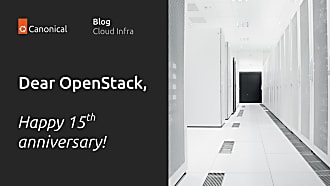Canonical
on 2 January 2023
Hybrid cloud infrastructure modernisation
Public clouds enabled digital transformation at unprecedented speed. But their operational costs over time can be exacting as compute needs increase. Hybrid clouds emerged as an alternative to gain the benefits of both worlds: private infrastructure that allows for lower operational expenditures and tighter control, and public clouds that can scale with ease.
Organisations looking to adopt a hybrid cloud architecture should carefully consider their options for private cloud vendors, as well as their implications for application design and development, workload orchestration and long-term maintenance.

The journey to hybrid clouds
In the past, organisations used to maintain dedicated servers for individual services and operate infrastructure in conjunction with applications. These monolithic applications were relatively straightforward to develop at the outset but resulted in inefficient long-term resource utilisation and unnecessary operations overhead. Teams didn’t have the virtualisation and orchestration technologies they have today. So they spent hours upon hours maintaining dependencies between underlying operating systems and applications. If one part of the app experienced an increase in demand, everything had to be scaled up, sometimes even costly dedicated servers.
The main promise of the cloud was to provide lower total cost of ownership (TCO) compared to legacy IT infrastructure. No longer would you need to invest in hardware. You could rely on public clouds, like the trailblazers at Amazon Web Services (AWS), to do that. But the cloud also offered something grander: on- demand resources for improved development agility. To fully reap these benefits, organisations embarked on a modernisation journey. They sought approaches to remake applications in a cloud-native way.
Instead of building applications and running them as a monolith, they split them into smaller components (microservices) that could be deployed, updated and operated independently. Just when a brave new world for computing seemed to be in order, organisations started facing new challenges. Each service had to run in a separate virtual machine (VM) or a container, leading to increasing cloud workloads and rising resource consumption.
Alongside this, something else was brewing: the amount of data organisations collect, store and analyse started to explode. What ensued was increased demand for resources to host applications and incremental spendings on public clouds. Data proliferation also paved the way for new regulatory regimes. Suddenly, public clouds were not always more economical, nor the best option to retain control over data and meet compliance and sovereignty requirements.
As a result, many organisations started exploring private cloud solutions. They realised that they could also build clouds on-prem, which offered a balance. After all, owning is more profitable than renting, especially long-term and at scale. Well-designed private clouds can also provide more architectural freedom. They usually provide better performance too, given that there is no resource sharing. Moreover, having control over underlying infrastructure enables organisations to meet compliance regulations.
Where private clouds fall short is the high CapEx cost. Leading private cloud providers, like VMware, require expensive licences to be purchased upfront, before the private cloud can even materialise. Private clouds also entail higher operational overhead. Lack of scalability, given extensive procurement processes, can also make them inadequate for some use cases.
That is why hybrid clouds emerged as a welcome alternative.
Read the Hybrid cloud strategy: a modernisation playbook for CTOs



